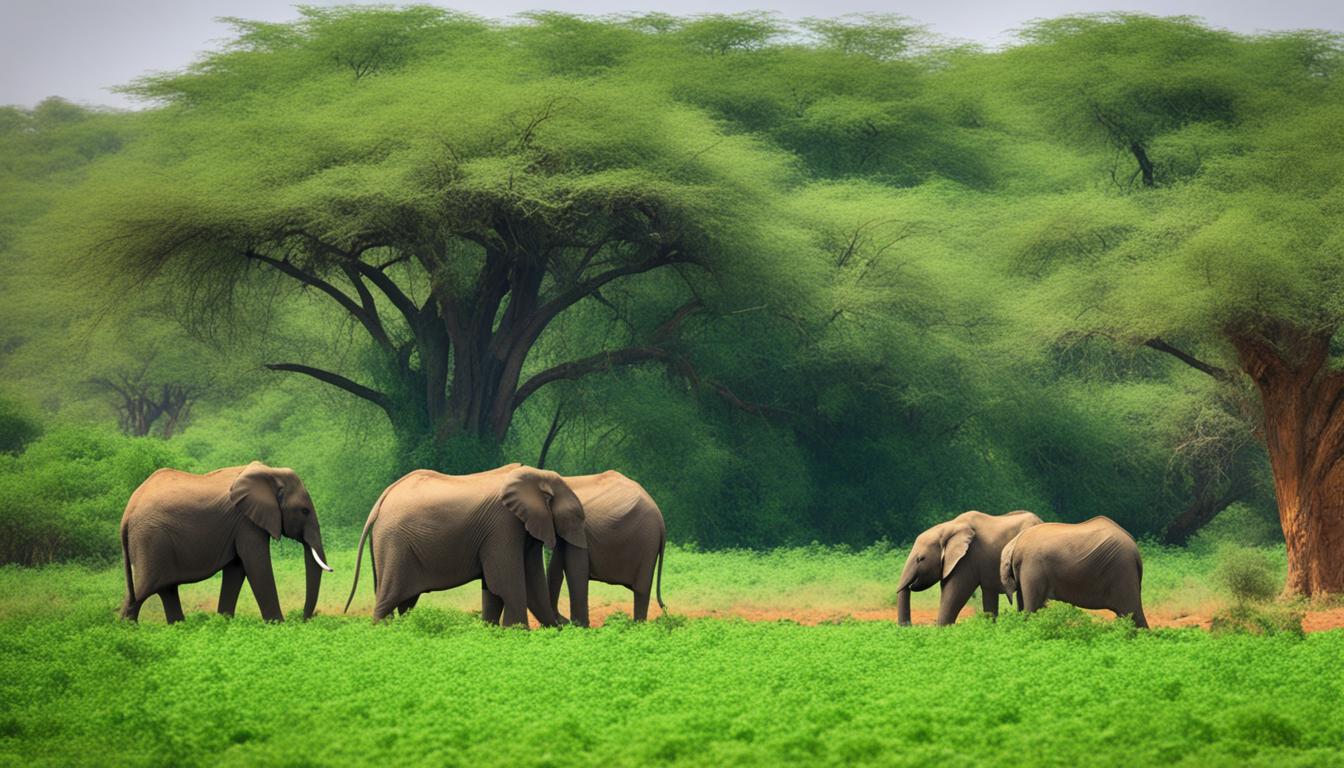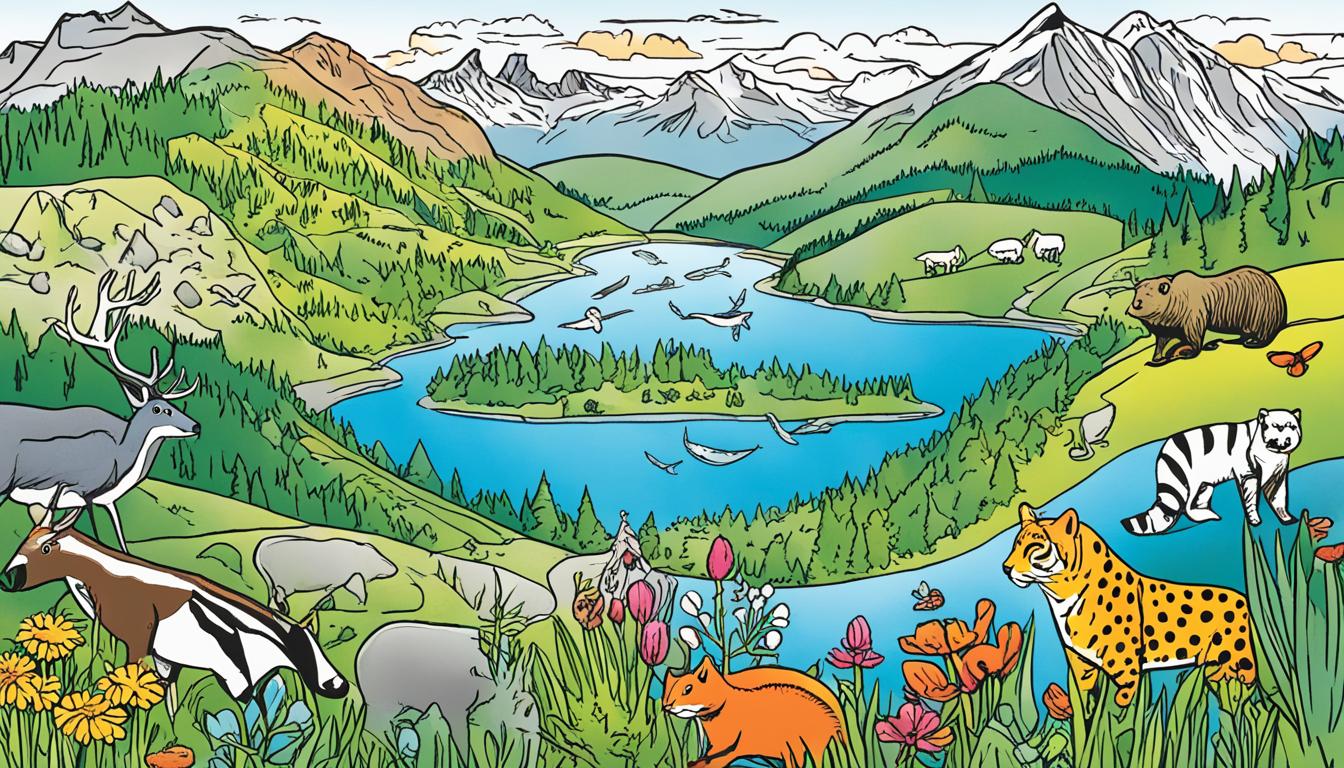Suriname Biodiversity: Animal and Plant Species and What Is Under Threat
Did you know that Suriname, a small country on the northeastern coast of South America, is home to over 5,100 plant species? This relatively unknown nation boasts a remarkable biodiversity, with a plethora of animal and plant species thriving in its diverse ecosystems. From the lush rainforests to the coastal mangroves, Suriname’s natural resources are teeming with life and harbour a wealth of unique wildlife.
Suriname’s biodiversity can be attributed to its varied habitats and favourable climate. The country is divided into four ecological zones, each providing a habitat for a wide range of species. These zones include the coastal plains, the savannah belt, the interior uplands, and the remarkable Guiana Shield mountains. Suriname’s rich biodiversity includes 192 mammal species, 715 bird species, 175 reptile species, 102 amphibian species, 360 marine fish species, and 318 freshwater fish species.
Key Takeaways:
- Suriname is known for its high biodiversity, with over 5,100 plant species and a wide variety of animal species.
- The country’s four ecological zones provide diverse habitats for numerous species, including mammals, birds, reptiles, amphibians, and fish.
- Suriname’s natural resources, such as its rainforests and mangroves, support a rich and unique wildlife population.
- The Guiana Shield mountains in Suriname are home to several endemic species.
- Protecting Suriname’s biodiversity is essential to ensure the long-term survival of its flora and fauna.
Threats to Suriname Biodiversity
The biodiversity in Suriname faces various threats. The main threats include habitat loss due to mining activities, especially gold mining, and unsustainable use of mangrove forests. Invasive species and illegal hunting and fishing also contribute to the decline of species populations. Suriname is home to endangered species such as the Atlantic goliath grouper and tapirs. The destruction of habitats and the disruption of ecosystems have a significant impact on the survival of flora and fauna in Suriname. Conservation efforts are essential to mitigate these threats and protect the unique biodiversity of the country.
Threats to Suriname Biodiversity
Suriname’s rich biodiversity, which encompasses its diverse flora and fauna, is under severe threat from various factors. The continued expansion of mining activities, particularly gold mining, poses a significant risk to the delicate balance of Suriname’s ecosystems. These activities result in habitat loss and degradation, disrupting the natural habitats of numerous species. Unsustainable practices, such as the use of harmful chemicals in mining operations, further exacerbate the negative impact on biodiversity.
Mangrove forests, a vital ecosystem in Suriname, are also under threat due to unsustainable use practices. These coastal habitats are crucial for various marine and bird species, providing nurseries and feeding grounds. The conversion of mangrove forests for agriculture, infrastructure development, and aquaculture has detrimental consequences for the survival of both plant and animal species that depend on these habitats for their existence.
Another significant threat to Suriname’s biodiversity is the introduction of invasive species. Invasive plants, animals, and microorganisms outcompete native species for resources, disrupt the natural balance of ecosystems, and can even drive native species to extinction. Suriname’s unique and endemic species are particularly vulnerable to these invasive threats due to their specialized adaptations and limited distribution.
Illegal hunting and fishing practices also contribute to the decline of endangered species in Suriname. Poaching for bushmeat and the illegal wildlife trade put immense pressure on various animal populations. The demand for rare and exotic species drives the illegal wildlife trade, leading to the exploitation of vulnerable species for commercial gain.
These threats collectively undermine the delicate equilibrium of Suriname’s ecosystems, jeopardizing the survival of numerous plant and animal species. Immediate action is required to mitigate these threats and conserve the country’s invaluable biodiversity.
Key Threats to Biodiversity in Suriname:
- Habitat loss due to mining activities, especially gold mining
- Unsustainable use of mangrove forests
- Invasive species
- Illegal hunting and fishing
The table below provides an overview of some endangered species in Suriname:
| Endangered Species | Conservation Status |
|---|---|
| Atlantic Goliath Grouper | Critically Endangered |
| Tapirs | Endangered |
Conservation Efforts in Suriname
Suriname has implemented various conservation measures to protect its biodiversity and preserve its unique ecosystems. The country has established 11 nature reserves, 4 Multiple Use Management Areas (MUMAs), and 1 nature park, covering a total area of approximately 2.1 million hectares or 13.5% of the country’s land surface.
These protected areas serve as crucial sanctuaries for Suriname’s diverse flora and fauna. They aim to preserve and protect important natural and cultural features while regulating scientific, educational, and recreational activities. By safeguarding habitats and ecosystems, these protected areas contribute to the long-term sustainability of Surinamese ecosystems.
“The establishment of nature reserves and protected areas plays a vital role in biodiversity conservation efforts. These areas not only provide a safe haven for endangered species but also ensure the preservation of Suriname’s natural heritage for future generations,” said Dr. Maya Singh, an expert in Surinamese ecosystems.
Suriname is actively involved in international efforts for biodiversity conservation. The country is a signatory to the Convention on Biological Diversity and the Convention on International Trade in Endangered Species of Wild Fauna and Flora. This demonstrates Suriname’s commitment to global conservation initiatives and collaboration with other nations.
The Surinamese government has developed a comprehensive National Biodiversity Strategy and a National Biodiversity Action Plan. These strategic documents provide a roadmap for conservation efforts in the country, addressing key challenges and guiding sustainable management practices.
Protected Areas in Suriname
The following table provides an overview of the main protected areas in Suriname:
| Protected Area | Area (hectares) | Main Objectives |
|---|---|---|
| Central Suriname Nature Reserve | 1,600,000 | Preservation of intact tropical rainforest and conservation of endemic species |
| Galibi Nature Reserve | 4,200 | Protection of important sea turtle nesting beaches |
| Brownsberg Nature Park | 12,800 | Conservation of tropical rainforest and promotion of sustainable tourism |
| Wia Wia Nature Reserve | 350,000 | Preservation of mangrove ecosystems and protection of bird species |
| Bigi Pan Nature Reserve | 133,000 | Protection of wetland habitats and migratory bird species |
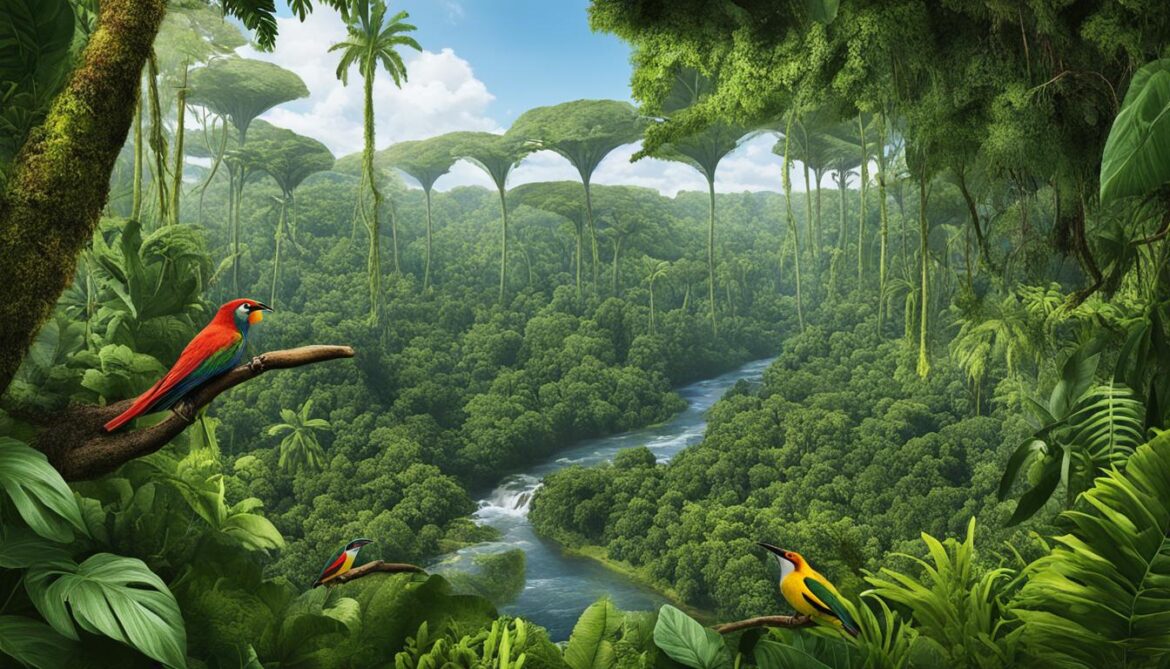
Indigenous and Community Involvement in Biodiversity Conservation
Indigenous and local communities in Suriname play a vital role in the conservation of biodiversity and the protection of Suriname’s unique flora and fauna. These communities possess traditional knowledge and practices that contribute to the sustainable use and management of natural resources, making them key stakeholders in conservation efforts.
With a deep connection to the land and its biodiversity, indigenous and local communities have a vested interest in preserving the balance and integrity of Suriname’s ecosystems. Their involvement is crucial for the long-term preservation of suriname animal species and the sustainable utilization of suriname natural resources.
Collaborative approaches, such as community-based conservation and the establishment of Indigenous and Community Conserved Areas (ICCA), have proven effective in safeguarding habitats and restoring species populations. These initiatives empower local communities to actively participate in the protection and restoration of their natural environment.
By integrating traditional knowledge with modern conservation practices, indigenous and local communities contribute to the broader goal of biodiversity conservation in Suriname. Their efforts ensure the continued existence of suriname wildlife and the preservation of Suriname’s ecological heritage for future generations.

Role of Indigenous Communities in Biodiversity Conservation
Indigenous communities in Suriname have a profound understanding of the local ecosystems and the interdependence between species. Their traditional knowledge about medicinal plants, sustainable hunting practices, and regenerative agriculture contributes to the conservation of suriname animal species and their habitats.
“Through collaborative initiatives, indigenous communities ensure the preservation of suriname wildlife and sustainable utilization of suriname natural resources.” – [Name of Indigenous Community Leader]
Community-Based Conservation Initiatives
Community-based conservation initiatives engage local communities as active participants in biodiversity conservation. These initiatives promote the establishment of conservation areas managed by the community, ensuring the sustainable use of resources and the protection of suriname animal species. By empowering local communities with decision-making authority, these initiatives create a sense of ownership and responsibility towards the preservation of Suriname’s biodiversity.
- Establishment of Indigenous and Community Conserved Areas (ICCA)
- Participatory Land Use Planning
Indigenous and Community Conserved Areas (ICCA) are territories where indigenous and local communities conserve biodiversity through traditional practices and sustainable resource management. These areas serve as sanctuaries for wildlife, nurturing suriname animal species populations while maintaining the cultural and spiritual significance of the land.
Participatory land use planning involves collaboration between indigenous communities, local stakeholders, and government agencies to develop land management strategies that balance conservation objectives with the needs of local communities. This approach ensures that biodiversity conservation is integrated with the sustainable use of suriname natural resources.
Through inclusive and participatory conservation initiatives, indigenous and local communities contribute to the protection and restoration of Suriname’s biodiversity. Their knowledge, practices, and deep connection to the land are invaluable assets in the ongoing effort to safeguard suriname wildlife for future generations.
Challenges in Biodiversity Conservation
Biodiversity conservation in Suriname faces several challenges. Limited resources and personnel make it difficult to enforce hunting regulations and monitor activities that threaten biodiversity. The unsustainable use of natural resources, including mining and logging, puts additional pressure on ecosystems and habitats. Climate change and natural disasters also pose risks to biodiversity, affecting the resilience and survival of species. Addressing these challenges requires increased funding, capacity-building, and improved coordination among stakeholders.
Challenges in Monitoring and Enforcement
The conservation of Suriname’s rich and diverse ecosystems is hindered by limited resources and personnel. This makes it challenging to effectively enforce hunting regulations and monitor activities that impact biodiversity. Without adequate monitoring and enforcement, illegal hunting and destructive practices can go unchecked, posing a significant threat to Suriname’s wildlife and plant species.
The Unsustainable Use of Natural Resources
Suriname’s natural resources, such as its rainforests and ecosystems, are under increasing pressure from unsustainable practices like mining and logging. These activities result in habitat destruction, fragmentation, and loss, which in turn threatens the survival of numerous species. Balancing the extraction of natural resources with sustainable practices is crucial to ensure the long-term health and viability of Suriname’s ecosystems.
Climate Change and Natural Disasters
Climate change and natural disasters also pose significant challenges to biodiversity conservation in Suriname. Rising temperatures, changing rainfall patterns, and more frequent extreme weather events can disrupt ecosystems and impact the distribution and abundance of species. These changes in climate can have cascading effects throughout Suriname’s ecosystems, affecting the delicate balance of its flora and fauna.
“Addressing the challenges in biodiversity conservation requires a multi-faceted approach, involving increased funding, capacity-building, and improved coordination among stakeholders. Only by working together can we protect Suriname’s invaluable rainforests, ecosystems, and the species that call them home.”

| Challenges | Impact |
|---|---|
| Limited resources and personnel | Difficulties in monitoring and enforcement |
| Unsustainable use of natural resources | Habitat destruction and species loss |
| Climate change and natural disasters | Ecosystem disruption and species vulnerability |
Addressing these challenges is vital for the long-term preservation of Suriname’s biodiversity. Through increased funding, capacity-building, and collaborative efforts, we can ensure the survival and thriving of Suriname’s rainforests, ecosystems, and the countless species that rely on them.
The Role of Tapirs in Suriname Biodiversity
Tapirs play a crucial role in Suriname’s biodiversity. These herbivorous mammals aid in seed dispersal, contributing to the growth and regeneration of plant species in the rainforest. Tapirs have a unique digestive system that allows them to eat a variety of fruits and plants, effectively spreading seeds across different areas. As they move through the forest, tapirs deposit seeds in their droppings, providing opportunities for new plants to thrive and diversify the ecosystem.
Tapirs’ feeding habits make them essential for maintaining the balance of Suriname’s rainforest. They consume large quantities of fruits, which helps control the population of fruiting trees and prevents them from becoming dominant. This diversity in tree species promotes a healthy forest ecosystem by ensuring adequate resources for other animals and supporting overall biodiversity.
The Role of Tapirs as Indicator Species
Tapirs also serve as indicator species, reflecting the health and balance of ecosystems in Suriname. Their presence or absence can provide insights into the overall well-being of the rainforest. Tapirs require large areas of undisturbed habitat with access to food and water sources. Thus, the presence of tapirs indicates the presence of intact ecosystems suitable for supporting diverse wildlife populations.
However, the decline in tapir populations can be a warning sign of ecological disturbances. Habitat loss due to deforestation, human encroachment, and agricultural expansion poses a significant threat to tapirs and other wildlife species. Therefore, protecting tapir habitats becomes a crucial step towards preserving the delicate balance of Suriname’s biodiversity.
“Tapirs play a vital role in maintaining the integrity and resilience of Suriname’s rainforest ecosystems. Their feeding habits and role as indicator species highlight the importance of their conservation to ensure the long-term survival of Suriname’s rich fauna and flora.” – Dr. Maria Santos, Wildlife Conservationist
The Gentle Giants of Suriname
Tapirs are affectionately known as “gentle giants” due to their calm and docile nature. As the largest land mammals in South America, tapirs have a unique appearance with a short trunk-like snout and a distinctive body shape. They move gracefully through the forest, relying on their keen senses to navigate in their habitat.
The tapirs’ gentle demeanor and fascinating characteristics make them a beloved part of Suriname’s natural heritage. They capture the imaginations of locals and visitors alike, becoming symbols of the country’s diverse wildlife and the importance of conservation efforts.
To celebrate the beauty and significance of tapirs in Suriname, here’s an image that showcases their unique features:
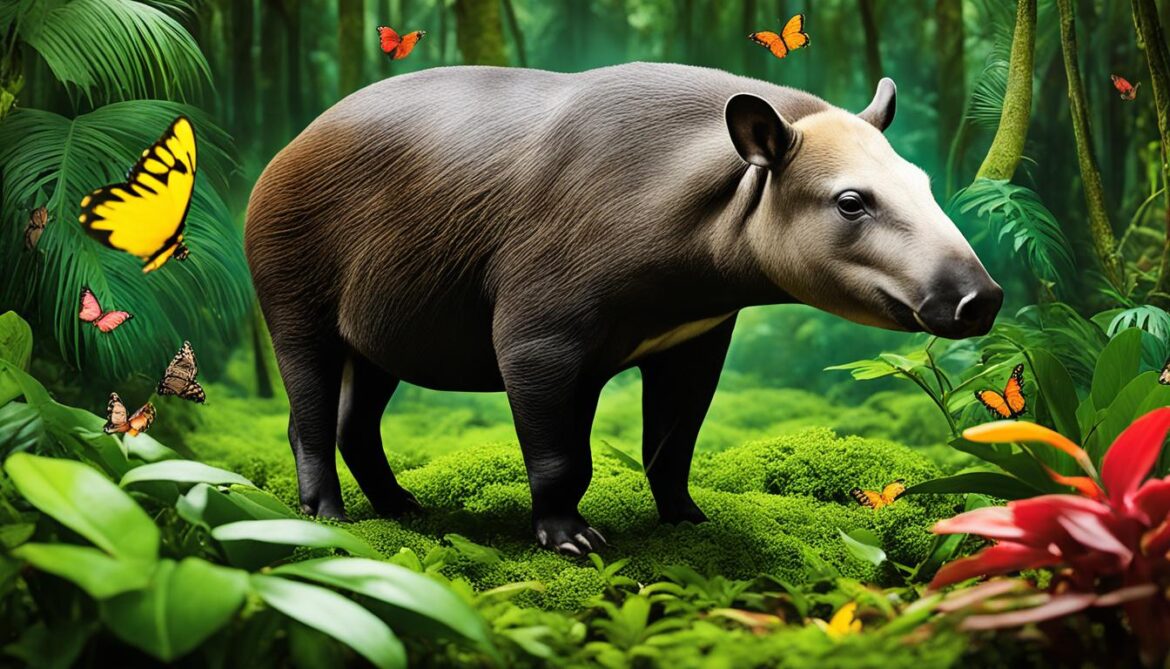
| Tapir Species in Suriname | Conservation Status |
|---|---|
| Baird’s Tapir (Tapirus bairdii) | Endangered |
| South American Tapir (Tapirus terrestris) | Vulnerable |
Suriname is home to two tapir species: Baird’s Tapir and the South American Tapir. These magnificent creatures require our attention and conservation efforts to ensure their survival amidst growing threats.
By recognizing the crucial role of tapirs in Suriname’s biodiversity and taking collective action to protect their habitats, we can safeguard the future of these “gentle giants” and preserve the delicate balance of Suriname’s natural heritage.
Tapir Hunting in Suriname
Suriname is the only country in South America where tapir hunting is allowed during specific times and regions. The hunting law establishes an open season for tapirs from June to August. However, tapirs are still hunted outside the designated season, posing a threat to their populations.
Conservation organizations, such as Conservation International Suriname (CIS) and WWF, are working with local communities and Indigenous groups to raise awareness, support habitat conservation, and promote responsible hunting practices.
Efforts are underway to update the hunting calendar and enhance enforcement of hunting regulations to protect tapirs and other endangered species.
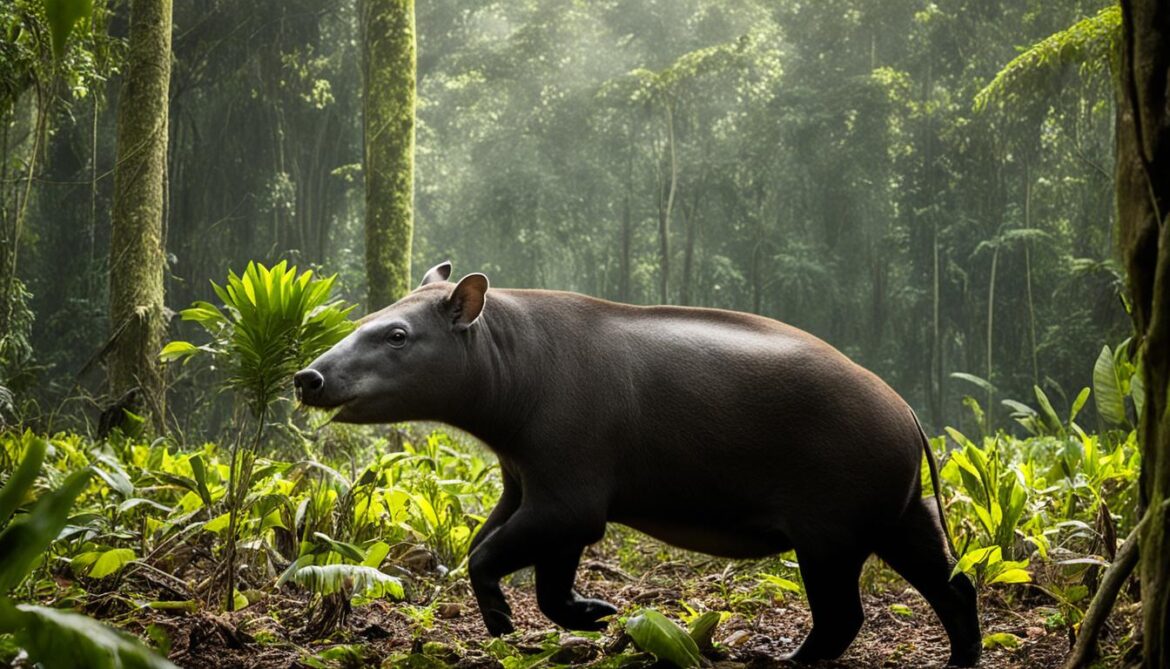
Conservation Organizations in Action
Conservation International Suriname (CIS) and WWF are actively engaged in protecting the tapir population in Suriname. Through community outreach and education programs, they are raising awareness about the importance of tapir conservation.
“By working together, we can ensure a brighter future for tapirs and other endangered species in Suriname,” says John Green, director of Conservation International Suriname.
CIS and WWF are collaborating with local communities to establish sustainable hunting practices and conserve tapir habitats. They are also advocating for stricter enforcement of hunting regulations to protect tapirs and prevent further population decline.
The Importance of Tapir Protection
Tapirs play a significant role in Suriname’s biodiversity. As large herbivores, they help maintain the balance of ecosystems by dispersing seeds and promoting the growth of plant species.
Additionally, tapirs serve as crucial indicators of the overall health of Suriname’s ecosystems. Their presence reflects the well-being and abundance of other species within their habitats.
“Protecting tapirs is essential for maintaining the delicate balance of Suriname’s rich biodiversity,” says Dr. Sarah Turner, senior scientist at WWF.
Preserving tapir populations not only ensures the conservation of a unique and iconic species but also helps safeguard the entire ecosystem and the countless other plant and animal species that rely on it.
Future Goals for Tapir Protection in Suriname
The conservation of tapirs is of utmost importance for the long-term preservation of Suriname’s biodiversity. To ensure the survival of this endangered species, future goals have been identified, focusing on proactive measures and community involvement.
Updating the Hunting Calendar
To better align hunting activities with conservation needs and tapir reproduction cycles, the hunting calendar in Suriname is set to be updated. This will help regulate and control hunting activities, reducing the potential negative impact on tapir populations. By implementing a more strategic hunting schedule, tapirs can have better chances of thriving in their natural habitats.
Research and Conservation Strategies
Research plays a vital role in formulating effective conservation strategies for tapirs. In-depth studies on tapir populations and their habitat requirements will provide valuable insights into the species’ behaviors, breeding patterns, and ecological needs. This knowledge will guide conservation efforts and ensure the implementation of targeted measures to safeguard tapir populations in Suriname.
Establishing an Indigenous and Community Conserved Area (ICCA)
The establishment of an Indigenous and Community Conserved Area (ICCA) holds great promise in protecting tapir habitats and engaging local communities in conservation efforts. An ICCA provides a platform for indigenous peoples and local communities to take a leading role in safeguarding their natural heritage. Through their traditional knowledge and sustainable practices, these communities contribute significantly to tapir protection and the preservation of Suriname’s unique biodiversity.
“Empowering local communities as custodians of their land and involving them in conservation decisions are fundamental steps towards ensuring the future of tapirs in Suriname. The establishment of an ICCA will support community-led initiatives while promoting a deeper connection between people and nature.” – Local community leader
Collaboration for Conservation
An integrated approach involving government agencies, conservation organizations, and local communities is crucial for tapir protection in Suriname. Collaboration facilitates the sharing of resources, expertise, and best practices, leading to more effective conservation outcomes. Through joint efforts and mutual support, the long-term survival of tapirs and their invaluable contribution to Suriname’s biodiversity can be secured.
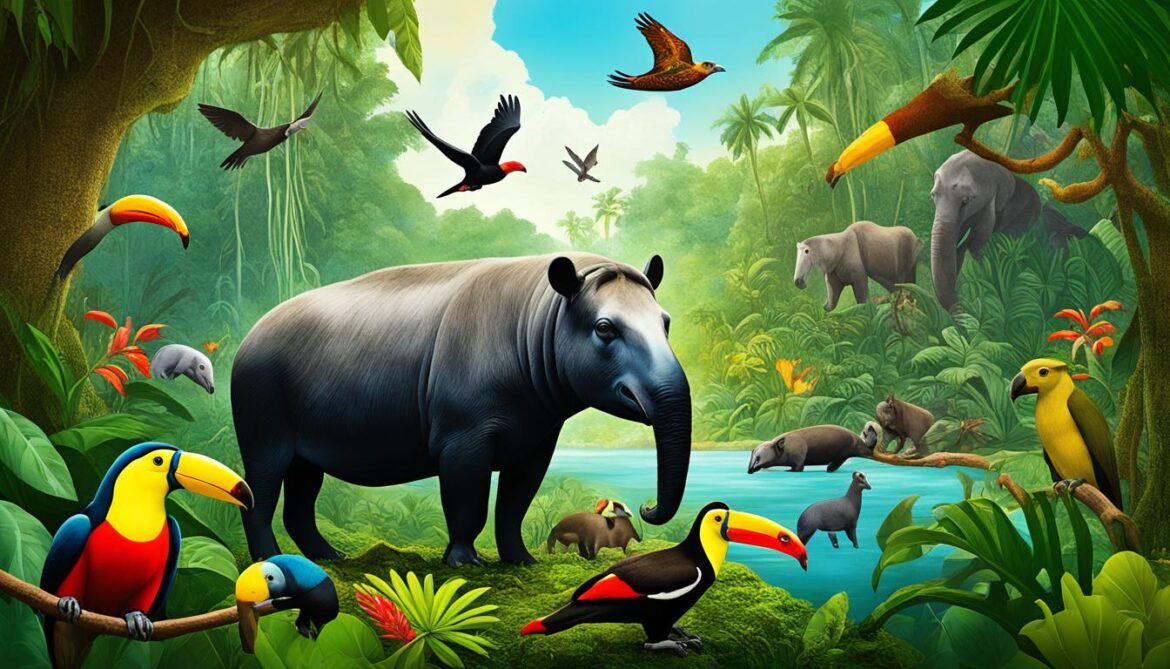
The image above depicts the beauty and vulnerability of the tapir, representing the urgent need for conservation in Suriname.
The Importance of Biodiversity Conservation
Biodiversity conservation is crucial for maintaining the integrity and resilience of ecosystems. Suriname’s diverse habitats and species contribute to the overall health and functioning of the environment. Biodiversity provides essential ecosystem services such as clean air and water, climate regulation, and nutrient cycling. It also has cultural, social, and economic value, supporting livelihoods, tourism, and traditional knowledge systems.
“Biodiversity is the foundation of life on Earth. It is the web of life, the intricate connections between species that sustain ecosystems and enable life to flourish.”
By protecting and conserving biodiversity in Suriname, we ensure the long-term sustainability of the country’s natural resources and contribute to global conservation efforts.
Biodiversity in Suriname is a treasure that must be safeguarded for future generations. The lush rainforests, pristine rivers, and diverse ecosystems support a vast array of plant and animal species. It is our responsibility to protect and preserve these resources, not only for their intrinsic value but also for their contribution to our well-being.
The Benefits of Biodiversity Conservation
Beyond its intrinsic value, biodiversity conservation offers numerous benefits:
- Ecosystem Services: Biodiversity sustains essential ecosystem services, such as pollination, soil fertility, and natural pest control. Without these services, our agricultural systems, food security, and overall well-being would be severely compromised.
- Climate Regulation: Forests and other ecosystems play a significant role in regulating the global climate by absorbing carbon dioxide and releasing oxygen. Preserving Suriname’s rainforests helps mitigate climate change and its impacts.
- Medicinal Potential: Many plant and animal species in Suriname rainforests hold untapped medicinal potential. Conserving biodiversity allows for the discovery of new drugs, treatments, and therapies that can benefit human health.
- Cultural Heritage: Suriname’s biodiversity is deeply intertwined with the cultural heritage of its indigenous communities. Traditional knowledge systems and practices related to biodiversity conservation are invaluable and must be respected and preserved.
Conservation efforts in Suriname should focus on preserving critical habitats, establishing protected areas, promoting sustainable resource management practices, and fostering community involvement. Through collaboration and international cooperation, we can ensure the long-term survival of Suriname’s rich biodiversity and contribute to global conservation goals.
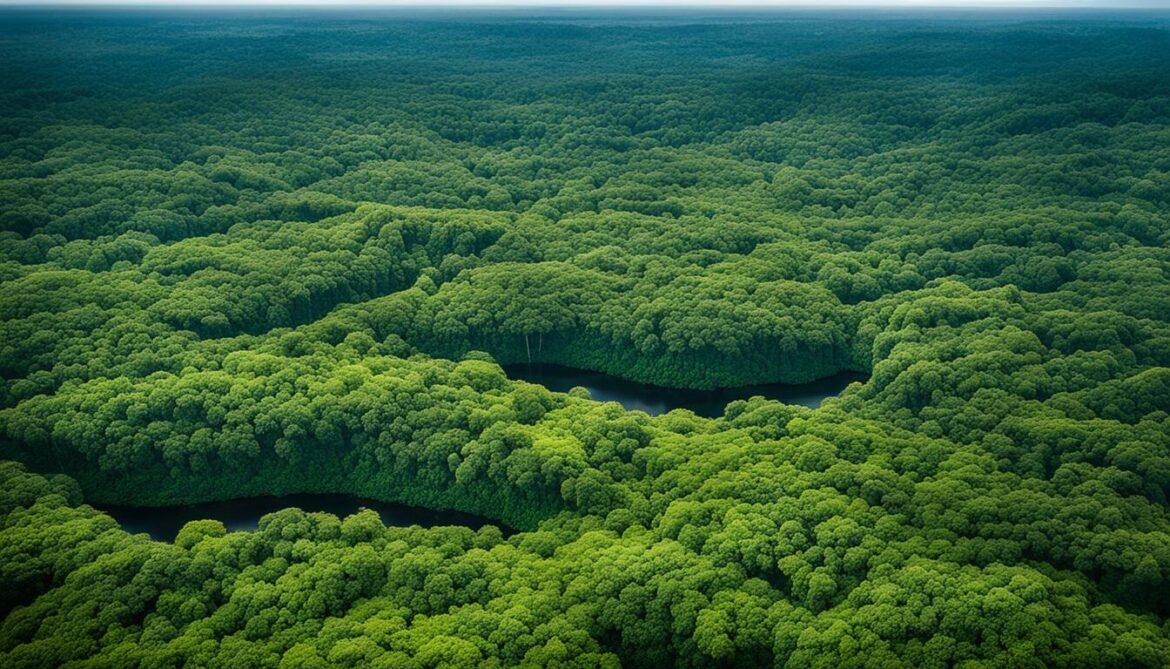
Conclusion
Suriname boasts a remarkable diversity of animal and plant species, thanks to its unique ecosystems that range from rainforests and mangroves to savannahs. However, this biodiversity is under threat due to habitat loss, hunting, and the impacts of climate change. To safeguard the rich flora and fauna of Suriname, it is imperative to prioritize conservation efforts.
The establishment of protected areas, community involvement, and sustainable resource management are crucial in preserving Suriname’s biodiversity. By creating designated areas where wildlife can thrive undisturbed, we can protect vital habitats and ensure the survival of species that call Suriname home.
Collaboration and international cooperation play a pivotal role in addressing the challenges facing Suriname’s biodiversity. By working together, we can enhance the effectiveness of conservation initiatives, share knowledge and resources, and secure the long-term sustainability of Suriname’s natural heritage for future generations to enjoy.



